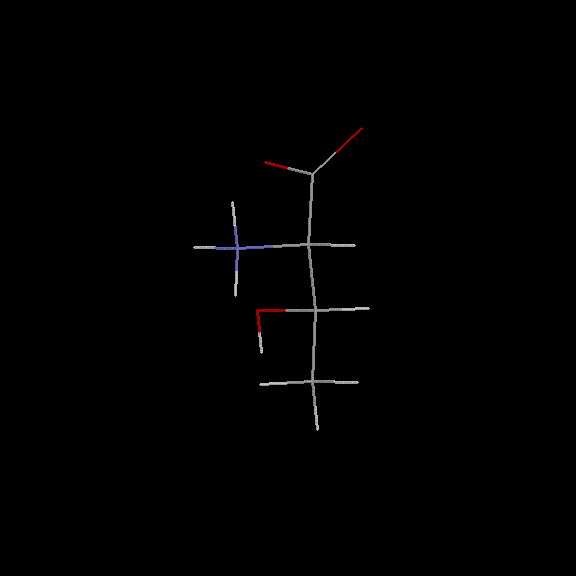L-threonine
Threonine (IUPAC-IUBMB abbreviations: Thr and T) is an α-amino acid, with its L enantiomer being one of the 22 proteinogenic amino acids and one of the 9 essential amino acids for humans. It is coded in messenger RNA by the codons ACU, ACC, ACA, and ACG. Structurally akin to valine, threonine is characterized by a hydroxyl group on the β-carbon. Consequently, it has two asymmetric carbon atoms, with the threo diastereoisomer (2S,3R) being substantially more abundant in natural systems, whereas the allo diastereoisomer (2S,3S) is relatively rare.
The alcohol function in threonine makes it susceptible to specific post-translational modifications, such as O-glycosylations or phosphorylations by protein kinases.
Synthetic threonine, obtained through fermentation, is of high purity, reaching 98.5%.
Threonine plays a vital role in various biological processes. Apart from its incorporation into proteins during translation, threonine is crucial for the biosynthesis of proteins, contributing to the overall protein structure and function. Additionally, threonine acts as a precursor for the biosynthesis of several important compounds in the body, including glycine and serine, which are essential for the synthesis of nucleic acids and phospholipids.
Furthermore, threonine is involved in the regulation of immune function, aiding in the production of antibodies and fostering a healthy immune response. Its role in maintaining overall health and well-being highlights its significance in the body's various metabolic pathways.
Biological Significance: Threonine plays a crucial role in protein biosynthesis and structural stability, aiding in the proper folding and functioning of proteins. It also serves as a precursor for the synthesis of other essential compounds, including glycine and serine, which are integral to nucleic acid and phospholipid production.
Metabolic Functions: Threonine serves as a vital contributor to several essential metabolic pathways, facilitating the synthesis of various metabolites and signaling molecules necessary for cellular function and regulation.
Immune Regulation: The role of threonine in supporting immune function is noteworthy, as it contributes to the production of antibodies and promotes a robust immune response, thereby aiding in the maintenance of overall health and well-being.
Post-Translational Modifications: Due to its alcohol functional group, threonine acts as a target for post-translational modifications such as O-glycosylations and phosphorylations by protein kinases, impacting protein activity and function.
Pure Synthetic Threonine: Threonine synthesized through fermentation processes exhibits a high level of purity, typically reaching 98.5%. This pure form underscores its utility in various industrial and biological applications, highlighting its importance in the realms of biotechnology and medicine.

Synonyms :
- L-THREONINE
- Thr
- T
Config Rule :
% 'L-threonine'
config('L-threonine',[
chain([
carboxyl,
car(1,amino&&hyd;),
car(2,hyd&&hydroxyl;&& (methyl(3)~))])]).
Smiles String :
[C@2H]([NH3+])([C](=[O])[O-])[C@2H]([CH3])[OH] 'L-threonine'
Fischer Diagram :

Terminal :
% 'L-threonine'
c(1,12,(0,chiral))-[n(1,left)~,h(1,right)~,c(4,up)~,c(2,down)~],
c(2,12,(0,chiral))-[h(5,left)~,o(1,right)~,c(1,up)~,c(3,down)~],
c(3,12,(0,nonchiral))-[h(6,left)~,h(7,right)~,c(2,up)~,h(8,down)~],
c(4,12,(0,nonchiral))-[o(2,nil)?,o(3,nil)?,c(1,down)~],
h(1,1,(0,nonchiral))-[c(1,left)~],
h(2,1,(0,nonchiral))-[n(1,right)~],
h(3,1,(0,nonchiral))-[n(1,down)~],
h(4,1,(0,nonchiral))-[n(1,up)~],
h(5,1,(0,nonchiral))-[c(2,right)~],
h(6,1,(0,nonchiral))-[c(3,right)~],
h(7,1,(0,nonchiral))-[c(3,left)~],
h(8,1,(0,nonchiral))-[c(3,up)~],
h(9,1,(0,nonchiral))-[o(1,nil)~],
n(1,14,(1,nonchiral))-[h(2,left)~,c(1,right)~,h(3,up)~,h(4,down)~],
o(1,16,(0,nonchiral))-[c(2,left)~,h(9,nil)~],
o(2,16,(-5.0E-01,nonchiral))-[c(4,nil)?],
o(3,16,(-5.0E-01,nonchiral))-[c(4,nil)?]
The Terminals for all the Config Rules are in Prolog Definite Clause Grammar (DCG) form.They can be checked in the Manual here.
The compound's PDB file can be seen here.
